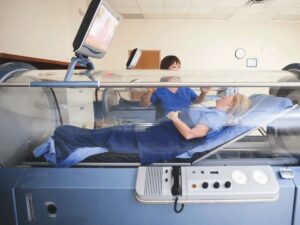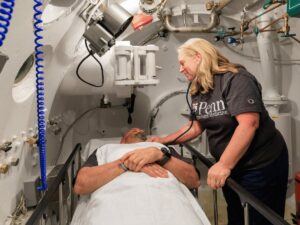What is the success rate of Hyperbaric Oxygen Therapy (HBOT)? Current data and clinical experiences suggest significant positive outcomes for various conditions treated with HBOT.
With years of expertise in hyperbaric technology and its medical applications, my insights offer valuable knowledge on this therapy’s efficacy.
In this article, we will explore key statistics, success stories, and the diverse applications of HBOT across medical and athletic fields.
Dive deeper into the transformative potential of HBOT!
1. Understanding Hyperbaric Oxygen Therapy
Hyperbaric Oxygen Therapy (HBOT) offers a sophisticated approach to healing by allowing individuals to inhale pure oxygen in a pressurized environment. As a non-invasive treatment, HBOT is effective for a broad range of conditions, from sports injuries to complex medical issues, providing a tranquil opportunity for patients to rest or sleep during the roughly two-hour sessions.
The significance and efficacy of HBOT are underscored by its projected market growth, with insights from Grand View Research indicating a compound annual growth rate (CAGR) of 4.9% from 2023 to 2030 for the global hyperbaric oxygen therapy devices market. This growth reflects the increasing recognition of HBOT as an indispensable treatment across various health and athletic settings.

2. Criteria for Success in HBOT
Building on our understanding of hyperbaric oxygen therapy, it’s clear that this treatment holds significant potential for a wide range of applications. Here are the factors that contribute to the success of HBOT:
Patient Selection
Selecting the right patients is crucial. Not every condition benefits from HBOT, so careful evaluation of the patient’s health status and medical history is essential. This includes assessing the potential for oxygen toxicity and ensuring that the benefits outweigh any risks. It’s about finding the right match between therapy and patient needs, enhancing the chances of a successful outcome.
Treatment Protocol
The success of HBOT also hinges on a well-defined treatment protocol. This involves determining the appropriate pressure levels, duration, and frequency of sessions tailored to each specific condition. Precision in these parameters can significantly influence the therapy’s effectiveness, making it a critical factor for achieving the desired outcomes.
Technological Compatibility
Technology plays a crucial role. The type and quality of the hyperbaric chamber used can affect treatment outcomes. For instance, modern, well-maintained chambers equipped with comfortable and safe environments are more likely to deliver positive results. This is where the choice of technology partners, like OxygenArk, matters, impacting the overall success rate of the therapy.
Post-treatment Care
Finally, the importance of post-treatment care cannot be overstated. Successful HBOT goes beyond the therapy session, involving careful monitoring of the patient’s response and adjustments as needed. Here’s the bottom line, effective follow-up care guarantees that any complications are managed promptly and that the patient’s recovery process continues smoothly.

3. Success Rates Across Different Conditions
Following the outlined criteria for Hyperbaric Oxygen Therapy (HBOT) success, we see distinct advantages in treatment outcomes across various medical challenges. Here are notable conditions where HBOT excels:
Wound Healing
In wound healing, especially diabetic foot ulcers, HBOT shines with a success rate often exceeding 80%. By delivering oxygen to the wound site, the therapy accelerates healing, decreases the risk of infections, and in many cases, significantly reduces the necessity for amputation. This is critical for patient recovery, as enhanced oxygen levels promote the formation of new blood vessels and collagen.
Carbon Monoxide Poisoning
For individuals suffering from carbon monoxide poisoning, HBOT has proven to be a critical treatment, with success rates for reducing severe neurological outcomes reported at around 75%. This therapy quickly displaces carbon monoxide from hemoglobin, restoring oxygen levels to normal and preventing the cascade of cellular damage typically seen in these patients.
Neurological Conditions
Neurological conditions, including stroke and traumatic brain injuries, have also seen promising results with HBOT. Studies indicate improvements in brain function and quality of life in up to 60% of treated cases. It just gets better. This therapy’s ability to also enhance oxygen delivery to the brain can aid in reducing swelling, mitigating injury effects, and fostering neural recovery.
4. Challenges and Limitations in Measuring HBOT Success
After exploring the impressive success rates of Hyperbaric Oxygen Therapy across various conditions, it’s natural to delve into the complexities of measuring these outcomes. Here are the primary challenges and limitations faced in this endeavor:
Individual Patient Responses
Variability in individual patient responses presents a significant challenge. Anyone will agree that each person’s body reacts differently to HBOT, influenced by factors like age, overall health, and the severity of the condition being treated. At OxygenArk, this diversity means that while one patient may experience rapid and significant improvements, another with a seemingly similar profile might progress more slowly.
Standardization of Treatment Protocols
The lack of standardized treatment protocols across different healthcare settings is another hurdle. With HBOT, the pressure settings, duration, and frequency of sessions can vary widely depending on the facility’s preferences or the treating physician’s judgment. This inconsistency makes it difficult to compare results directly and establish a clear baseline for success, potentially skewing the perception of HBOT’s effectiveness.
| Healthcare Setting |
Pressure Settings |
Duration of Sessions |
Frequency of Sessions |
Result Comparison |
| Hospital |
1.5 ATA |
90 minutes |
Daily |
Challenging due to wide variation |
| Specialty Clinic |
2.0 ATA |
120 minutes |
Three times a week |
Limited comparability due to differing parameters |
| Private Practice |
1.3 ATA |
60 minutes |
Twice a week |
Difficult to establish consistent benchmarks |
| Research Facility |
Varied |
Varied |
Varied |
Inconsistent due to lack of standardization |
| Military Institution |
2.5 ATA |
150 minutes |
Biweekly |
Struggle for uniformity hampers evaluation |
Measuring Long-term Effects
While immediate improvements may be evident, understanding the lasting impact of the therapy requires extended follow-up and comprehensive data collection. And here’s why that’s important, long-term studies are essential to appreciate the scope of HBOT’s benefits fully, yet such research is time-consuming and resource-intensive, often beyond the capacity of many treatment centers.
5. 4 Factors Influencing HBOT Success
Recognizing the challenges in measuring the success of Hyperbaric Oxygen Therapy, it’s essential to pinpoint the factors that directly impact its outcomes. Here are the key elements that influence the effectiveness of HBOT:
#1 Precise Oxygen Levels
The concentration of oxygen used during therapy is a critical determinant of success. HBOT requires delivering 100% oxygen at pressures higher than atmospheric levels to saturate the body’s tissues. The precise calibration of oxygen levels ensures that the treatment can effectively assist in healing and recovery. Too little oxygen might not provide the desired therapeutic effects, while too much could lead to oxygen toxicity.
#2 Optimal Pressure Settings
The pressure settings within the hyperbaric chamber are another vital factor. For instance, the efficacy of HBOT depends on the ability to increase atmospheric pressure to a point where oxygen can dissolve into the plasma and reach areas where circulation is diminished. Similarly, each condition may require a specific pressure to achieve the best results, making the customization of treatment protocols crucial.
#3 Session Duration and Frequency
The length and number of HBOT sessions significantly influence therapeutic outcomes. Standard treatments might range from 60 to 120 minutes and can be administered once or twice daily, depending on the severity and type of condition. Adequate session timing allows for maximal oxygen absorption, while the frequency ensures sustained effects over time.
#4 Patient’s Overall Health
Finally, the patient’s general health and lifestyle choices can affect the success of HBOT. Individuals with better circulatory and respiratory function typically respond more positively to the therapy. Additionally, factors like smoking or certain medical conditions can impair oxygen delivery, thereby reducing the effectiveness of HBOT. Encouraging patients to maintain a healthy lifestyle can complement the therapy and enhance its benefits.
Dive Deeper Into Our Resources
Looking for more diverse product options? Browse through our handpicked selections:
Still haven’t found what you’re looking for? Don’t hesitate to contact us. We’re available around the clock to assist you.
Conclusion
Hyperbaric Oxygen Therapy has demonstrated its effectiveness across a wide range of applications, from medical treatment to enhancing athletic performance. The therapy’s ability to increase oxygen delivery to tissues promotes healing, and supports recovery, making it a valuable tool in various wellness settings.
For those looking to integrate or upgrade HBOT capabilities, OxygenArk provides unparalleled support and expertise. Contact us today to discover how we can enhance your therapeutic offerings.


